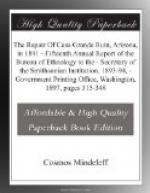Plate CXVI shows the character of these blocks. The material employed was admirably suited for the purpose, being when dry almost as hard as sandstone and nearly as durable. A building with walls of this material would last indefinitely, provided a few slight repairs were made at the conclusion of each rainy season. When abandoned, however, sapping at the ground level would commence and would in time bring down all the walls; yet in the two centuries which have elapsed since Padre Kino’s visit to this place—and Casa Grande was then a ruin—there has been but little destruction from the elements, the damage done by relic hunters during the last twenty years being, in fact, much greater than that due to all causes in the preceding two centuries.
The building was well provided with doorways and other openings, arranged in pairs, one above the other. There were doorways from each room into every adjoining room, except that the rooms of the middle tier were entered only from the east. Some of the openings were not used, and were closed with blocks of solid masonry, built into them long prior to the final abandonment of the structure.
CONDITION OF CASA GRANDE IN 1891
The south and east fronts of Casa Grande seem to have suffered, particularly from the weather, and here rainstorms have probably caused some of the damage. The outer faces of the walls are of the same material as the wall mass, all the masonry being composed of earth from the immediate site. In the construction of the walls this soil was laid up in successive courses of varying thickness, whose limits form clearly defined and approximately horizontal joints. The northeast and southeast corners of the building have entirely fallen away, and low mounds of their debris still show many knobs and lumps, parts of the original wall mass.
The destruction of the walls was due mainly to undermining at the ground level. The character of this undermining is shown in many of the illustrations to this report, especially in plate CXVI, and its extent is indicated on the accompanying ground plan (plate CXVII) by dotted lines within the wall mass. Although the material of which the walls are composed is very hard when dry, and capable of resisting the destructive influences to which it has been subjected for a long time, yet under certain conditions it becomes more yielding. The excessively dry climate of this region, which in one respect has made the preservation of the ruin possible, has also furnished, in its periodic sandstorms, a most efficient agent of destruction. The amount of moisture in the soil is so small as scarcely to be detected, but what there is in the soil next to the walls is absorbed by the latter, rising doubtless by capillary attraction to a height of a foot or more from the ground. This portion of the wall being then more moist than the remainder, although possibly only in an infinitesimal degree, is more subject to erosion by flying sand in the windstorms so frequent in this region, and gradually the base of the wall is eaten away until the support becomes insufficient and the wall falls en masse. The plan shows that in some places the walls have been eaten away at the ground level to a depth of more than a foot. Portions of the south wall were in a dangerous condition and likely to fall at any time.




